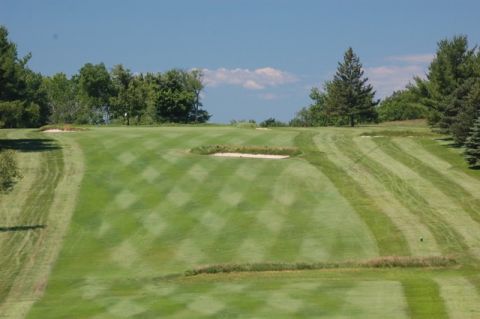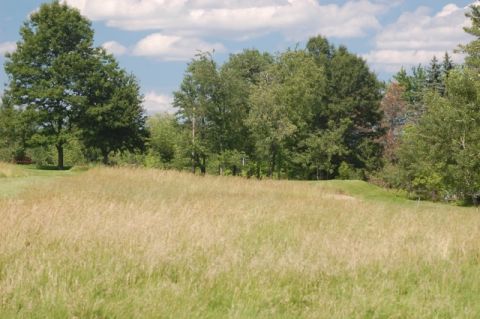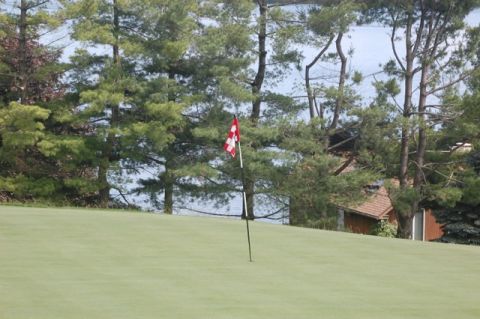It was a glorious day, temperatures topping out at about 75 by early afternoon, and the ride from my Connecticut home was free of traffic or annoyingly slow drivers. Most of the trip is west on US 44, which runs through a combination of small towns still clinging to their farming roots as well as through a few larger towns of faded glory, like Winsted, CT –- hometown of everyone’s favorite windmill tilter, Ralph Nader. The last 10 miles of the trip wind through Berkshire foothills forests and pastureland before a steep hill brings you up to the unpaved Copake parking lot and a thoroughly unpretentious clubhouse, set at the highest point on the hilly layout.

The first at Copake is an ideal starter, not too long at 369 yards, generous of fairway, but with some trouble, and straight uphill, a fair preview of the rest of the challenging course.
Copake and the Orchards Golf Club in South Hadley, MA, which I had played just 10 days earlier, were built originally within a year of each other -– Orchards in 1921 by Donald Ross and Copake in 1922 by Devereaux Emmet. Of course, thanks to the Ross name and having hosted the U.S. Women’s Open in 2004, The Orchards is much better known. But in terms of quality, condition, layout and attention to detail, I preferred Copake.
For one, Copake is a more visually interesting golf course with significant elevation changes –- often twice on the same hole, with elevated tees, sunken sloped fairways and elevated greens. Parts of the adjacent Copake Lake are within sight of at least half the holes but only as a pleasant distraction, since the water never comes close to the field of play. Like so many lakes that became vacation spots early last century, all the prime waterside real estate was taken up with houses, with the high ground reserved for golf. At just two hours from New York City, Copake Lake does not appear to have lost any of its glory; I heard plenty of squeals of delight from lake revelers as I made my way around the golf course (more background noise than distraction).

You know you are in the foothills of the Berkshires when you approach the par 4 2nd hole at Copake. Note that Copake's greenskeeper has resisted the temptation to "groom" the edges of the bunkers, adding even more to the "classic" feel of the golf course.
The course is beautifully maintained, although its lowest elevations did take on and hold a lot of water from heavy rains a few days earlier. Unfortunately, it was difficult to figure out where the soggy parts were in the rough until you were on top of them; in some spots, the deep tire furrows made by previous cart drivers was warning enough. The fairways are double cut into a crosscut pattern you expect from the best major league baseball stadia; instead of aiming at a tree or building in the distance, you can pick out a diamond of grass in the fairway. Golf course owner Jon Urban shows a healthy reverence for the classic layout by keeping rough where most modern golf courses pave over with cart paths. The back edges of bunkers are rimmed in fescue, adding to the look of class (and classic). Suffice to say turf on tees and fairways are solid and worthy of summer rules; I didn’t have any sand or grass seed in the one divot mix container in the cart, but most divots came up clean and were easily replaced.
of grass in the fairway. Golf course owner Jon Urban shows a healthy reverence for the classic layout by keeping rough where most modern golf courses pave over with cart paths. The back edges of bunkers are rimmed in fescue, adding to the look of class (and classic). Suffice to say turf on tees and fairways are solid and worthy of summer rules; I didn’t have any sand or grass seed in the one divot mix container in the cart, but most divots came up clean and were easily replaced.
The greens at Copake are small, crowned, firm and speedy, and the greens keeper must have been in a foul mood early that morning because many pin positions were on little hills near the front or back of the sheer putting surfaces. That said, I didn’t note many flat places in which to punch in cups. I’ll take the back pin positions at Copake any day, even risking a potential downhill chip from just off the back rather than attempt to get close to the front pin positions set just over steeply faced false fronts; fall short and you are facing bogey or worse from below the green. I don’t recall more than a few level putts from behind the pins, even after a good approach shot landed on the front part of the green. The heavy rains of a few days earlier did little to soften the significantly elevated greens (they, of course, drain first).

The 353-yard par 4 10th at Copake moves up the same hill as the opening hole, but its trouble mostly awaits pulled shots. Copake's owner is offering a building lot for sale to the right of the fairway, with an additional view of the lake.
I noticed golfers of all age groups out on the course, but Copake plays especially friendly for those of us who no longer hit our drives well beyond 200 yards off the tee but still want the thrill of playing from the tips. You can do that at Copake, where the back (White) tees are set at just 6,216 yards total, with a course rating of 70.3 and a slope of 131. The toughest holes on the card tend to be the longer par 4s, although the 472-yard par 5 4th hole is rated the 3rd toughest on the course, largely because the second or third shot to its green must surmount a two-story hill topped by a putting surface that reminded me of the Beatles’ haircuts in the ‘60s. (I will always have a soft spot for the 4th, largely because, after my blind hit-and-pray sand wedge, I made a six-foot putt for my only birdie of the day.)
Some flourishes at Copake are especially unusual for a country golf course, especially one that charges a mere $38 for us seniors (over 60), and just $45 for the rest of you. Virtually every tee box included a wooden bench behind it, and at one confluence of three tee boxes, a hammock was strung between trees, ostensibly for respite for those hearty few who choose to walk the extremely hilly layout. Every tee box included a functioning ball washer that, in the era of cost cutting, has become a rare sight. Since my ball picked up mud and grass stains on virtually every shot, this was a blessing.

One of the par 3s at Copake, the 151-yard 8th, includes a blind tee shot. Here, at the challenging 188-yard 17th, you at least get to see the flag beyond the heather.
Copake is decidedly not a golf community; the only time you see a concentration of homes is along the 17th and 18th fairways, on the far side of Golf Course Road, which runs along the lake. There are no homes on the golf course itself, although owner Jon Urban has two large lots for sale, with views of both the golf course and the lake, for $575,000 each (contact us if you would like more information). One of them, set beside and above the fairway on the par 4 10th hole, is a short walk from the clubhouse where we spied some nicely filled plates being served to a lunch crowd; the public restaurant, called The Greens, is reported to serve excellent dinners as well.
There is nothing fancy about Copake Country Club, but then solidly classic golf courses don’t require fancy. Because of its location, Copake will never host a U.S. Women’s Open –- but its golf course could. If you are visiting the Berkshires or passing near the area on the Taconic Parkway, Copake is definitely worth a four-hour stop.

The par 5 18th at Copake finishes beside its namesake lake. Homes are only in sight on the 17th and 18th holes, across Golf Course Road.
*
Copake Country Club, 44 Golf Course Road, Craryville, NY, 12521, 518-325-4338. White Tees: 6,216 yards, Par 72, rating 70.3, slope 131. Yellow Tees: 5,510, 71, 71.2, 121. Red Tees: 5,329, 72,71.2, 121.



